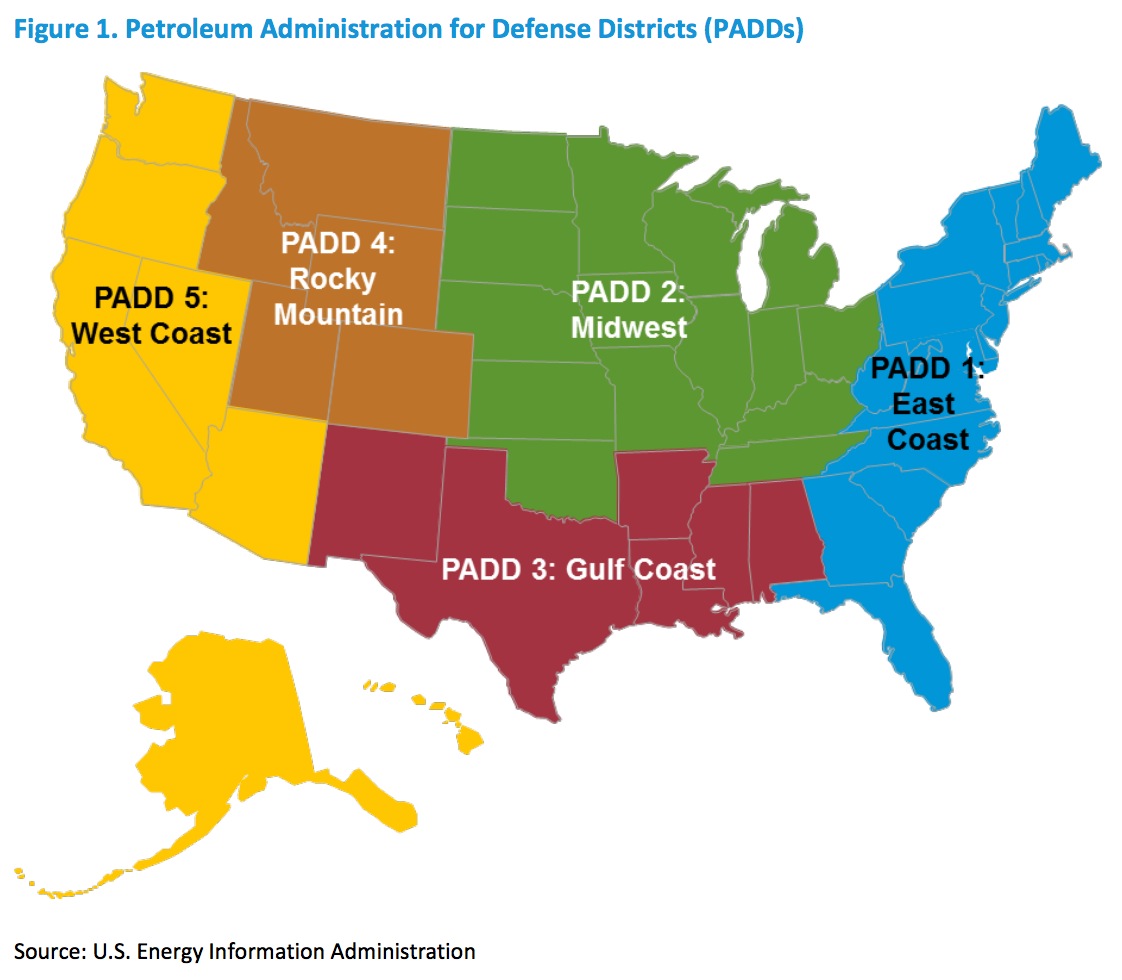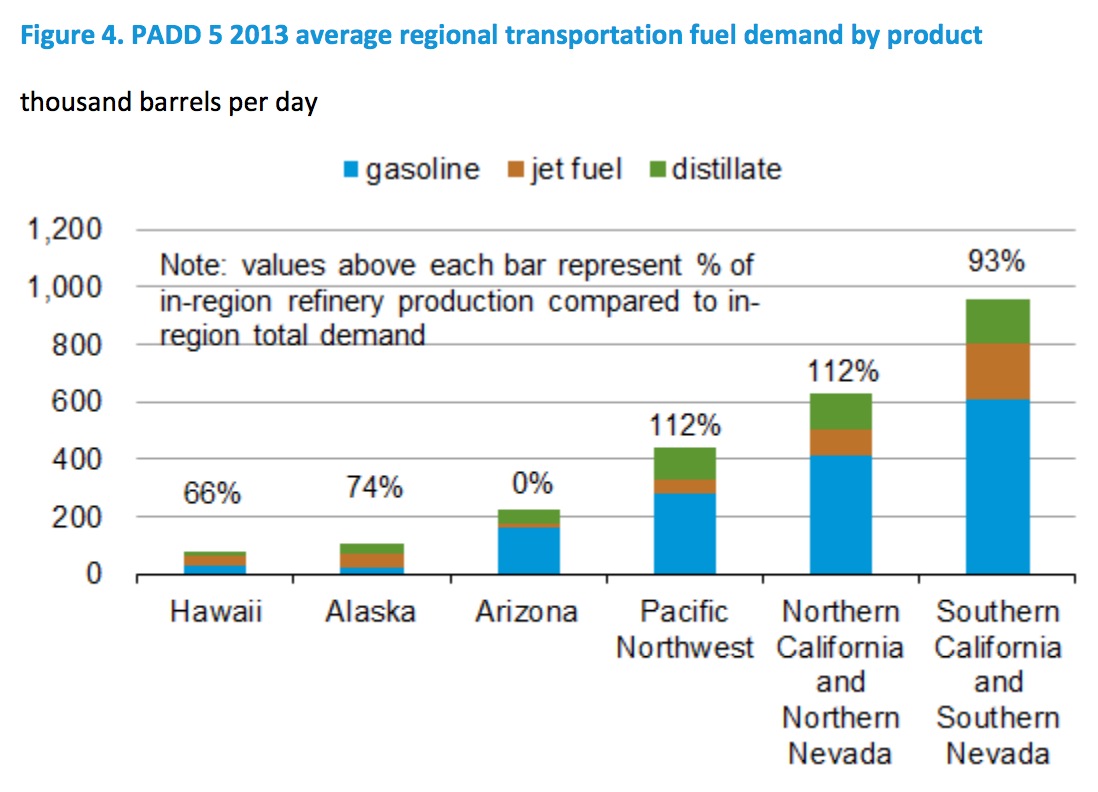UNITED STATES ENERGY INFORMATION ADMINISTRATION
This study examines supply, demand, and distribution of transportation fuels in Petroleum Administration for Defense District (PADD) 5, a region that includes the western states of California, Arizona, Nevada, Oregon, Washington, Alaska, and Hawaii. For this study, transportation fuels include gasoline, diesel fuel, and jet fuel.
This study is the first in a series of studies that the U.S. Energy Information Administration (EIA) plans to conduct to inform its analyses of petroleum product markets, especially during periods of supply disruption and market change.
This study examines transportation fuels supply, demand, and distribution at both the PADD level and for specific areas within the PADD, which are referred to as sub-PADD regions in this analysis. PADD 5 covers a large and diverse geography, and supply/demand balances and supply patterns vary within the region. The study identified six distinct regional markets within PADD 5: Southern California and Southern Nevada; Northern California and Northern Nevada; Pacific Northwest, which includes Washington and Oregon; Arizona; Hawaii; and Alaska.
For each of these regional markets as well as for PADD 5 as a whole, the study considers demand, supply, supply patterns, and distribution infrastructure, using 2013 as a base year and taking into account expected changes in balances and infrastructure in subsequent years. Demand includes inregion consumption, transfers of fuels to other parts of the United States (other PADDs) and to other regional markets within PADD 5, and exports to the global market. Supply includes in-region refinery production, receipts of fuels produced in other U.S. regions and other PADD 5 regional markets, and imports. Distribution infrastructure includes storage terminals, pipelines, rail facilities, marine loading and unloading facilities, and marine vessel availability.
EIA retained Stillwater Associates, an Irvine, California-based transportation fuels consultant, to conduct the research and analysis for the PADD 5 study. Stillwater analyzed data and information from EIA, the California Energy Commission (CEC), the Army Corps of Engineers Waterborne Commerce Statistics Center, and publicly available data from various sources.
Additional studies are planned to analyze PADD 5 crude supply, PADD 1 (East Coast), and PADD 3 (Gulf Coast) transportation fuels markets, and PADD 2 (Midwest) and PADD 4 (Rocky Mountains) transportation fuels markets.
Executive Summary
In 2013, PADD 5 accounted for 17%, or 1.5 million barrels/day (b/d), of total U.S. gasoline consumption, 13%, or 494,000 b/d, of distillate (including diesel fuel) consumption, and about 30%, or 430,000 b/d, of jet fuel consumption. Consumption varies across PADD 5 and is concentrated in California.
PADD 5 transportation fuels markets have features that often result in significant and persistent increases in prices in the wake of supply disruptions. The region is geographically isolated from other U.S. refining centers, notably the Gulf Coast, where 52% of U.S. refining capacity is located, and from global refining centers that can efficiently supply product to the U.S. East Coast (PADD 1). In addition, although pipelines can move products from the Gulf Coast as far north as New York Harbor on the East Coast, there are no pipelines that cross the Rocky Mountains to move product to the mainland states of PADD 5 from the Midwest, and only limited pipelines that deliver from the Gulf Coast to the southern regions of PADD 5 and from the small refineries in PADD 4 to the eastern regions of PADD 5. The West Coast is 10 days travel by tanker from the U.S. Gulf Coast, three weeks from Asia, and more than four weeks from Europe. Pipeline and marine infrastructure, as well as vessel availability to move product within PADD 5, are also limited.
Across PADD 5, specifications for motor gasoline and diesel fuel vary state-to-state and even within some states, making it difficult to cover product shortfall in one area with supply from another. In addition, some product specifications, like those for the California Air Resources Board (CARB) gasoline and diesel fuel, are difficult and costly to manufacture, and not all refineries in PADD 5, much less elsewhere in the United States or the rest of the world, can make such products. Even when refineries outside PADD 5 can manufacture product to meet these specifications, supplies generally are not kept on hand, further limiting resupply options when disruptions occur.
Because PADD 5 is isolated, in-region refineries are the primary source of transportation fuels for PADD 5. In 2013, PADD 5 refinery production was sufficient to cover about 91% of in-region motor gasoline demand, 96% of jet demand, and 113% of distillate demand. Heavy reliance on in-region production further complicates the supply chain when disruptions occur. When disruptions occur, all of these factors noted above combine to limit short-term supply options, lengthen the duration of supply disruptions, and cause prices to increase and remain higher for a longer period than would be typical in markets outside PADD 5.
The recent increase in gasoline prices on the West Coast following a series of supply disruptions that started with an unplanned refinery outage in February at a Southern California refinery provides a case in point. On February 18, an explosion and fire occurred at the third-largest refinery in Southern California. West Coast product markets reacted immediately to the potential loss of supply from the refinery, and spot gasoline prices quickly increased. The rapid price response is not unusual and is similar to what happened following past unplanned outages in that region. In the five weeks following the outage, West Coast total motor gasoline inventories decreased by 3.0 million barrels (10%), and remained below the five-year average for most weeks through August. Inventories provide an immediate, although limited, source of alternative supply but typically are insufficient to offset a prolonged market disruption. With limited resupply options from within the region and from within the United States, imports increased to replace in-region production. Because the refinery outage has not yet been resolved as of the writing of this report, PADD 5 has continued to rely on imports, which has lengthened the supply chain, making the region more susceptible to shipping delays and other supply chain disruptions. Gasoline prices on the West Coast increased sharply again in early July when, according to trade press, shipping delays caused gasoline cargoes destined for the West Coast to arrive later than anticipated. In addition, PADD 5 gasoline demand was up 4% in the first six months of 2015 compared with the same time last year, putting additional pressure on the supply chain.
There are 22 operating refineries in Washington, Oregon, California, Nevada, and Arizona, the mainland states of PADD 5. These refineries, which have total atmospheric distillation unit (ADU) capacity of 2.5 million barrels per calendar day (b/cd), are located primarily in and around Los Angeles and San Francisco, California, and Puget Sound in Washington. There are two operating refineries in Hawaii with combined crude distillation processing capacity of 147,500 b/cd and five operating refineries in Alaska with combined crude distillation capacity of 165,200 b/cd.
Download full version (PDF): PADD 5 Transportation Fuels Markets
About the U.S. Energy Information Administration
www.eia.gov
The U.S. Energy Information Administration (EIA) collects, analyzes, and disseminates independent and impartial energy information to promote sound policymaking, efficient markets, and public understanding of energy and its interaction with the economy and the environment.
Tags: California, EIA, Fuel, Gas, Petroleum, United States Energy Information Administration








 RSS Feed
RSS Feed